This article examines, through a performative narrative, an installation artwork that I created in May 2008 titled Admission. This artwork and reflective writing embodies a form of creative inquiry into issues surrounding and the intersections of (be)coming out, nonvisible disabilities, and representations of mental illness. Deleuze and Guattari's concepts of becoming and the rhizome inform my investigation into (be)coming out, not as an event thought of as a singular moment defined through a fixed notion of the subject, but as an ongoing process of creating connections between subjects understood as multiplicities. In its conclusions, this article proposes that the kind of inquiry characteristic of artmaking can offer unique opportunities for understanding the complexities of the intersections of subjectivity and (be)coming out as a person with a mental illness
Prologue
The performative narrative that comprises the main part of this paper is an interpretive piece of writing that explores an installation artwork I created in May 2008 titled Admission. This prologue is intended to provide additional context to this performative interpretation and the original installation artwork focusing particularly on how the ideas and issues raised and explored through the process of creative inquiry surrounding my creation and exhibition of Admission might inform current discussions surrounding "coming out," nonvisible disabilities, and representations of mental illness. An epilogue follows the performative narrative and serves primarily as a reflection on questions raised through the work.
I created the installation artwork Admission as a means through which to critically investigate my own (be)coming out as it intersects with challenging representational issues that surround living with a mental illness. The installation marked a critical intersection of representational issues, visuality, (be)coming out, confinement, and artmaking and emerged from my own experiences of being labeled "mentally ill"1 and hospitalized after the "deinstitutionalization"2 of mental healthcare. Admission explored challenging questions about how to represent oneself, to (be)come "out," within and through the stigmatizing discourses of popular understandings; historical constructs of madness, illness and treatment; cultural attitudes toward visible versus invisible disabilities as well as discourses surrounding the mythology of the "mentally ill" artist.
As a person who has bipolar disorder, I see my own "coming out" not as stepping from a lonely closet, but as an ongoing process of (be)coming out. Through this artwork I wanted to explore the complexities of "coming out" rather than what Brueggemann and Moddelmog (2002) describe as a "simplistic liberal politics ('Come out and stay out.')" (p. 332). In contrast to what is often called "coming out," I am in part grounding my exploration of the idea of (be)coming out in Deleuze and Guattari's (1987) discussions of the subject as "becoming." I am framing "coming out" in relationship to understanding subjects as complex multiplicities. Coming out develops into (be)coming out when understood as a process involving an ongoing relationship of connections rather than as a single moment in which a singular subject, understood as having an internal and individuated essential identity, declares and reveals his/her "truth," the "real me," to another essential subject or group of subjects. It is also not simply that a subject continues to "come out" as (s)he navigates everyday experience. The subject that is coming out is better understood as what Deleuze describes through the relational concept of the AND than to be. It is not a matter of being or not being bipolar, but that I am always in between and in relationship to and constructed through relationships and connections (Deleuze, 1995; Gibson, 2006). Therefore, I am not either "out" or "in." I am always both.
Barbara Gibson (2006) explores the possibilities of Deleuze and Guattari's understanding of the subject as active becoming in thinking about disability. Included in her writing is a discussion about how this understanding of the subject disrupts the idea of subjects as static and the binaries that result from and reinforce this idea. She writes:
A "subject" for Deleuze and Guattari is re-imagined as a continual "becoming" neither encased by skin and organs nor defined by static concepts and categorizations such as disabled/able-bodied, male/female, gay/straight or even person/thing. Becoming is identity-in-motion rather than fixed being. It is active, occupying an identity zone without becoming fixated with or fixed to any of its elements…. Becoming thus is a movement in the spaces between elements rather than being one thing or the other. (p. 190, emphasis in the original)
(Be)coming out as a person with a mental illness and as a person who has been hospitalized involves a complex matrix of representational issues including perceptions of what it means to "come out" as having an invisible disability and particularly a mental illness. This (be)coming out is from, within, and through multiple spaces of confinement whose walls are discursively constructed in many ways beyond the literal walls of a hospital. When we are made visible, people with mental illnesses are made specimen in the medical image and are made spectacles of violence and absurdity in popular culture. Our forms of self-representation become called "Outsider Art"3 and are then pillaged within therapeutic discourses that assume that through our work they can "see" our diagnoses and into our very being. These representational issues are made even worse when people with mental illnesses fear sharing our stories out of concern for the repercussions of stigmatization. Therefore, "admitting to" and (be)coming out as a form of public and personal intervention is a way of exploring the complexities of these representational issues.
While mental illness is highly visual in regards to its representation, mental illness itself most often remains a nonvisible disability. Therefore, (be)coming out involves asserting one's identity as a person with a mental illness within a cultural context that has constructed, through ongoing repetitions, particular notions about what mental illness "looks" like. These representations do not "look" like me. In Ellen Samuels (2003) discussion of coming out and visuality, she identifies the way in which "[s]uspicions of fraud often greet declarations of nonvisible identity" (p. 242). As Wendell (2001) describes, "the trustworthiness of people who claim to be disabled but do not look disabled is always in question" (p. 29). When I do not resemble what people think mental illness "looks" like and how a person with a mental illness is presumed to act, I experience suspicion about my intentions grounded in the assumption that I have something to gain or that my illness couldn't be that "serious" because I "look" and seem "fine." This puts me in a very challenging position in which I could recite a list of things that could effectively challenge these assumptions that I am really just "fine," but doing so would then lead to questions about my competency and not necessarily challenge the suspicions surrounding sharing this information. This aspect of (be)coming out is part of the challenging cycle of representational issues in which many people with mental illnesses find themselves.
In creating Admission, I began with the idea that it was these representational contexts that can become the very material through which to craft critical perspectives. I don't see the construction of my own narrative or critique as somehow being or becoming situated outside of and beyond these discourses. To see my work as moving beyond and outside would reposition the idea of the "real me" that is often thought to be asserted and represented in ways that are somehow beyond the influence and experience of other representations. Rather, I faced the conceptual challenge of how to represent through and within rather than beyond and outside, which embodies more the idea of assemblage than linear perspective. Within the context of artmaking, assemblage refers to three-dimensional artworks created from the combination of found objects. Assemblage is born of gathering and reassembling rather than drawing toward a single point to create the illusion of three-dimensional space. However, my use of the term assemblage is not so literal. Deleuze and Guattari (1987) describe a book as an assemblage having "only itself in connection with other assemblages…." The ideas of "multiplicity," "connection," and "heterogeneity" (pp. 7-9), described as characteristic of an assemblage by Deleuze, relate to his distinction between the book as "root" or "tree" (p. 5) and what he calls a "rhizome" (p. 6). A primary difference between the tree and rhizome are that trees are grounded in "binary logic" homogeneity, and singularity rather than multiplicity, connection, and heterogeneity (p. 5).
This process of working through and within resulted in works largely constructed through practices of layering and juxtaposing found objects and images from my own life. These objects were from experiences that are most often not "visible" to others such as private narratives and lost histories, the anonymity of hospitalization, and taking prescription medications. This process represents a kind of critical recycling of these personal artifacts. This process can also be linked with Deleuze and Guattari's (1987) discussion of what it means to be "rhizomorphous" (p. 15). "To be rhizomorphous is to produce stems and filaments that seem to be roots, or better yet connect with them by penetrating the trunk, but put them to strange new uses" (p. 15). In this way, I am taking the artifacts and experiences from my own life that are interpreted by others in order to arrive at particular ideas about me, but disrupt them, give them new purpose, and challenge what others would most often assume they mean all the while teetering on the borders of visibility and nonvisibility.
The exhibition space was organized into three areas through three works, titled Self-portrait, Landscape, and Still Life. In Self Portrait, photographs of the fabric from hospital gowns I was given while hospitalized are projected onto two large grids of white bread. Landscape involved the projection of a 1906 postcard of the Ohio Lunatic Asylum that stood for over a 100 years in the city in which I live. The image was projected onto a horizon created through a 15 foot line of my prescription bottles. Still Life was created through a juxtaposition of my belts onto one coat in a row of white doctors' coats hanging on hooks. As people moved through the gallery they constantly had to negotiate the space and walk in front of the light from the projectors that then cast their shadows onto the walls and work therefore situating themselves as another element juxtaposed within the work. The titles, each referencing canonical concepts in Western art, were also locations of juxtaposition.
The exhibition title was also juxtaposed with the artwork and space. The title of this installation, Admission, initially emerged from my thinking about two ways of understanding the word. The first was to be admitted and the second was to admit to. In one sense, admission references the ongoing experiences of (be)coming out and disclosure and the challenging and sometimes painful realities of what can result from these forms of admitting to . Admission also references the experience of confinement when admitted to hospitals and institutions and speaks to my own experiences of multiple hospitalizations and to my experience and knowledge of other people's stories and histories of confinement and institutional care.
However, through the visitors' engagement and participation with the work, my use of the word admission acquired other meanings. One meaning and form of admitting to involves the viewers' realization of and reflection upon preconceived ideas about people living with mental illnesses and issues related to mental health more generally. The visitors were confronted with their own ideas about mental illness, at times their own prejudices and discriminatory behaviors, and their own experiences. This kind of admitting to speaks to the potential this type of work has to enact cultural change by its extending beyond the confines of artistic intention. The viewers' participation with the work becomes an integral component of the work itself; a source of their own "becoming."
Where the work was exhibited and who typically visits this space on any given day were also integral aspects of creating this encounter. I selected the Fresh A.I.R. gallery in Columbus, OH, the city where I live, as the site for this installation. This gallery is funded by a mental health service provider and describes its mission as being for the exhibition of "the works of individuals affected by mental illness and/or substance abuse disorders. Through art, we educate the community and work to break down the stigma of mental illness and substance abuse by bringing focus to the artistic vision" (para. 2). An exhibition space for artists with mental illnesses cannot help but be connected with historical discourses of l'Art Brut, Outsider Art, and psychiatric art collections. My selection of this particular exhibition space was an intentional move toward creating an encounter where I would have to grapple with the implications of those discourses. L'Art Brut, Outsider Art, and psychiatric art collections most often fix artists' identities and do not create situations in which these artists can (be)come out. Rather, as an Outsider Artist I more often become a "mental patient" rather than an artist with a mental illness. My work becomes bipolar rather than being created by an artist with bipolar disorder. While developing literally within the context of psychiatric art collections in which artwork is used to analyze particular "pathologies," discourses of l'art Brut and Outsider Art often result in the same emphasis on pathology before agency that inhibits the potential for the multiplicity, heterogeneity, and connectivity characteristic of (be)coming out.
While questions about larger cultural ideas surrounding the "mentally ill" artist became part of the artwork, the way this exhibition space actually functions introduces into the work an important body of additional connections. The gallery was not a stagnant room, but an active, multipurpose space. The installation was in a passageway that people walked through in order to get to their jobs as mental health care providers, their apartments, and for mental health consumers getting to their appointments. Many people experienced the work as part of their everyday movement through this space. Outside, there were many people who were homeless, but they were banned from entering the building as a guard sat at a desk at the entrance. At the opening of the show, I saw a man outside the building that was homeless and recognized him as a person that was in the hospital with me. I was quickly reminded of my own privilege in being able to afford effective medical care and of the challenging issues of access that surround my own attempts at creating inclusive spaces.
Admission did not follow or create a linear, pre-determined, or concrete trajectory, but embodied an ongoing process of appropriation, juxtaposition, contradiction, and artificially harmonized discord. To this end, my analysis in the following performative narrative will diverge from more traditional forms of academic writing and attempt to embody the rhizomatic way in which this installation becomes an ongoing series of connections, questions, and contradictions rather than a linear trajectory toward a particular outcome or idea. My analysis is written as a performative narrative formed through a juxtaposition of images and text that navigates a complex body of intersections including: the viewer-participants; community; history; forms of self-representation; and social, political, spatial and temporal constructs of normality and "madness" and the "artworld."
Admission: A Performative Narrative
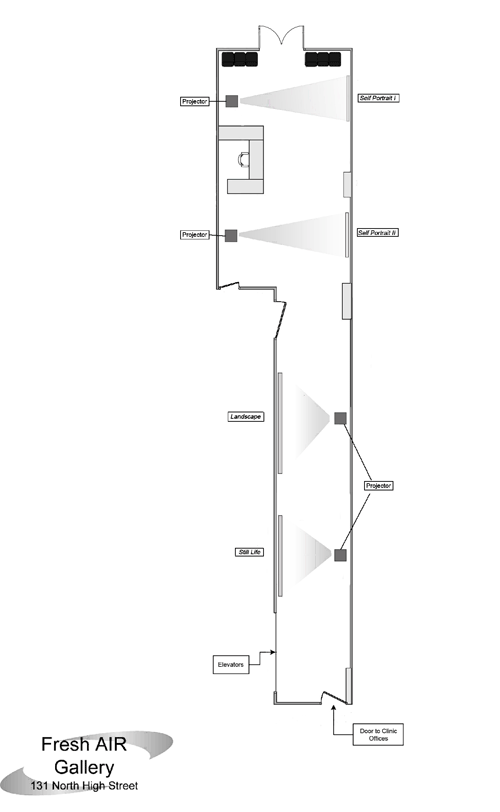
Admission.
Three works come together: self-portrait, landscape, and still life. I think of many trips to museums walking from room to room, painting to painting, with tired legs and this is what I see, self-portrait, landscape, and still life. They inhabit the same space, but side by side with no peripheral vision. They may actually speak to each other, but we don't hear it. We don't expect it.
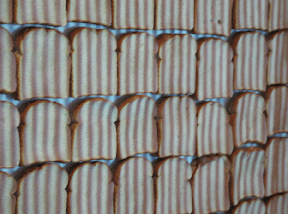
(Detail of Self Portrait in the installation Admission, 2008)
Self-Portrait.
bread, bread, bread, bread, bread, bread, bread….
I was served one individually wrapped piece of bread with every meal. Each piece was in a clear plastic wrapper sealed at both ends. I decided to save a piece of bread for every day I was there. I would sometimes wake up in the morning to find someone opening all of my drawers, every container, holding the spines of my books and fanning the pages watching for something to fall to the floor. Please don't take my bread. Please don't take my bread. She sees my eyes open and says only two words: ROOM CHECK. My room is evidently safe now. And I know that in 20 minutes someone carrying a clipboard will look for me again. Jennifer? Yes. CHECK.
breakfast, lunch, dinner, breakfast, lunch, dinner, breakfast, lunch, dinner…. Can I go home yet?
When I tell the bread story for the first time during a gallery talk the visitors are fascinated with why? Why this many pieces? Why bread? Why projected hospital gown fabrics?
They find glimpses of authenticity exciting — those are the pajamas and gown that I received in the hospital. And for a moment in this discussion they are REAL…but then they are only light, projections on white bread and now they are bacteria on microscope slides or jelly.
The bread that I saved is still in my closet at home and some of it is white, but the moisture has left and it gets smaller and smaller and some of it molded and became dust without ever opening a wrapper.
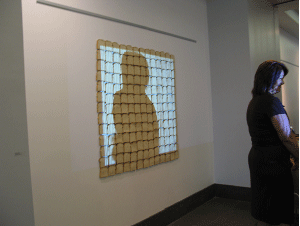
(Detail of Self Portrait in the installation Admission, 2008)
One woman asks, Did any of the hospital staff or doctors ever ask you about the bread?
No.
She then somewhat jokingly said, I wonder how they charted that? and I knew where she came from by her medical dialect. She has probably written in many more charts that have been written about her.
She then said, Think of what could have happened if the staff or your doctor had only asked about the bread. I imagine the potential of this conversation and realize that she sees this value as well.
These individually wrapped pieces of bread become bodies, preserved, confined, surveyed, controlled, and uniform.
Rows and rows of white bread become padded walls stained with isolation. They are no longer visible, yet I am continually bruised from bumping into what is no longer there.
There were no conversations for me with people who held charts and wore white coats even though they asked me every day how I was feeling. I later find out she is my state's Department of Mental Health Director and that the man she is with is the Deputy Director. I think about her point and find an awareness and reflexivity within it and realize my own assumptions about people who wear white coats and write in charts. However, it isn't that simple. She was wearing a blue suit.
A few seats away a man hesitantly speaks up. When I see that bread I think of my birds. Every morning I take bread outside and hang it in the trees. The birds just make me so happy. I saw a mother bird with her baby this morning and it made my day. I was a line chef for twenty years and have fed many people. I didn't go to college. Now I feed the birds. Later he introduces himself to me by calling himself a "paranoid schizophrenic" and I knew how he was charted.

(Detail of Landscape in the installation Admission, 2008)
Landscape.
Have you taken your medicine? I have your medicine.
These almost sound the same.
Have you taken your medicine? I have your medicine.
In the morning and evening, the nurses walk like waitresses with trays covered with small cups filled with pills and water. Each of us is a cup filled with pills. I have your medicine.
In the morning and evening, my husband will often ask, Have you taken your medicine? but I am not a cup filled with pills.
They almost sound the same. But they are not.
Asylum. Asylum.
They sound the same.
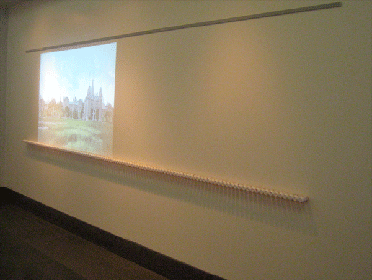
(Installation view of Landscape, 2008)
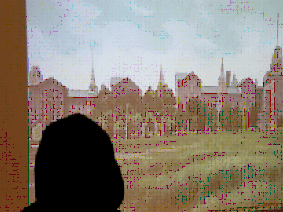
(Detail, Shadow of a person viewing Landscape, 2008)
The Ohio Lunatic Asylum opened in 1877 and claimed to be one of the largest "insane asylums" in the world. It was demolished fairly recently in the early 1990s and most of what remains are "asylum graveyards."
F 1275, F 5721, M 2481 M 1842. Many of these graves are labeled only by gender and a number.
There are many numbers. 60,000: A Nazi poster reads "60,000 RM is what this person with genetic defects costs the community during his lifetime. Fellow German, that's your money too."
T4 euthanasia program. 1939-1941, 126,000: the number of people labeled as mentally ill killed through the Nazi T4 Euthanasia program in places called hospitals.
I have your medicine.
1: The United States is the first country to create compulsory sterilization programs in 1907. 1928: The flashing light exhibit by the American Eugenics Society reads "This light flashes every 15 seconds. Every 15 seconds $100 of your money pays for the care of persons with bad heredity such as the insane, the feeble minded, criminals and other defectives." 65,000: the approximate number of forced sterilizations in the United States most often in places called hospitals.
I wonder what my number is.
Before the opening of Admission, I find out that a donor reviewed my proposal for this installation and was very interested in the work. I am told that she is a psychiatrist and the director of a large residential facility in the city where I live and that she has recently published a book about the Ohio Lunatic Asylum. I ask the gallery director, Does she understand the work? The answer isn't clear.
Later, I am given a copy of the book. Hilltop: A Hospital and a Sanctuary for Healing, Its Past and Its Future. There is a large stained glass window on the cover. I hear voices... stories about forced ice baths, physical restraints, electroconvulsive therapy, lobotomies, beatings, sexual abuse, forced sterilization, concentration camps and euthanasia programs.
One month, two months, three months; one year, two years, three years, four years.
My view of the asylum is not through a stained glass window.
I am told — -no, this was a good place. They tried very hard. They treated the patients well. They didn't know anything else. They did what they thought was best. I have your medicine.
A mental health worker later said, When I got home tonight I realized how much I danced around so as not to be cast into the Old Asylum. In an email another woman wrote about looking at the image of the asylum and now having the power to walk away from that place.
Someone else looked at the projection of the Ohio Lunatic Asylum and said to me, Isn't the architecture beautiful?
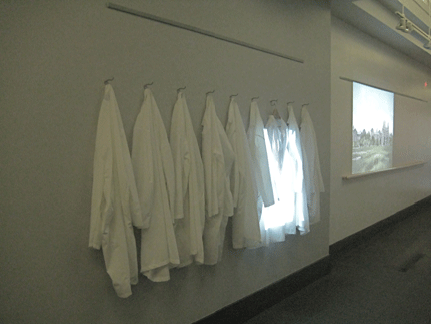
(Installation view of Still Life, 2008)

(Detail, Still Life, 2008)
Still Life.
For the longest time, I have had a box of belts in the back of my closet. It is a walk-in closet, a place that I can actually stand in. I tuck away things that other people will never see there. I know that the belts are in the closet even though I have never worn them.
While standing in the gallery a number of people asked me, Are those real restraints?
Lab coats or doctors' coats? Patient or Petri dish?
Hold still! My very active and independent two-year old daughter rolls around and kicks her legs as I attempt to change her diaper. Hold still! It is time to put your shoes on. Hold still! It is time to comb your hair. Hold still! It is time to brush your teeth. Hold still! I have your medicine.
Hold still! I know what is best for you.
In Madness and Civilization: A History of Insanity in the Age of Reason (1965), Michel Foucault describes how in the Middle Ages bars were installed at an asylum in Germany so that those outside would be able to view the madmen chained within (p. 68). Throughout history this desire to watch those labeled insane and mad persisted including people paying to watch people in asylums. Within the "art world" the relegation of art by people with mental illnesses into psychiatric art collections or its categorization as l'Art Brut and Outsider Art, can at times produce and/or reinforce a similar kind of pleasure experienced through this desire to look at difference.
Are those real restraints?

(Image from the opening reception of Admission)
At the opening, the director of Southeast, Inc. stands and reads into a microphone the mission statement for the gallery. I have heard it before, but it makes me uncomfortable: This gallery exhibits the works of individuals affected by mental illness…Through art, we educate the community…. I imagine the people, particularly those people attending the opening who didn't know this was the mission of the gallery, who are colleagues and students and I feel restrained. Individuals become a blurred mass, the always shifting "us" and "them." I see the title of my exhibition on the wall above his head. Admission…. this gallery exhibits the works of individuals affected by mental illness….Admission…. Buy your tickets…. Admission…. Take a look….
During the artist talk, I am asked, how do you feel when it is time to take it down? Is it hard that you can't keep it?
My response to her question was fairly academic.
Ephemeral. (definition) Short-lived; existing or continuing for a short time only.
I later realize that it is not my inability to keep it, but rather it is my inability to leave it behind that is hard.
Epilogue
In creating Admission, I envisioned the work and (be)coming out as an encounter. As an encounter, an unpredictable meeting and convergence, "coming out" became an ongoing process of the coming together of rather than a coming out to. The viewers and the space were active participants as neither was a blank slate. The viewers' experiences and the way the space functioned and created meaning became part of the work. The installation involved the creation of an interaction and an interposition and aimed to recognize how diverse circumstances result in unpredictable and spontaneous interactions, experiences, questions, and outcomes. The work was not simply about me, but rather was about the becomings of everyone that encountered the work and however it was that they did so.
This work grew from literal experiences of confinement and aimed to create an interactive and public encounter from actual experiences of hospitalization. The artifacts present in the installation reference confinement in regards to experiences of asylums and hospitals. However, through multiple becomings, the work connected with how discourses of madness and mental illness also confine and not simply the ways in which institutions exist as literal spaces of confinement. It is in this way, that (be)coming out is in relationship to multiple discursively constituted spaces of confinement.
I didn't know what would happen and what this exhibition would mean for me. As I sketched the idea on paper and later glued the pieces of bread down, I didn't know that someone would look at the work and tell me about how he feeds the birds every day and how now when I think of this work and the pieces of bread that I continue to save in my closet that I wonder about eating the bread and its loss and waste. I didn't anticipate meeting someone from the Ohio Department of Mental Health or the health care workers that attended the opening and artist talk and how I would be surprised at how insightful their interpretations were making me realize how many assumptions I have about them and the dangers of oversimplifying the relationship between "patient" and "doctor." I didn't imagine that a psychiatrist had recently published a book about the history of the asylum, the image of which I projected on top of a long line of my own prescription bottles. I didn't know how uncomfortable I would feel when I finally realized that she saw this asylum as a place of healing and that I saw it as a place that represented abuse and imprisonment. Nor did I expect how that would make me think more about the relationship between what we think actually happens in a particular space and how spaces might become more than what actually happens there.
Ultimately, through the process of this encounter, I arrived at many more questions than answers as my own (be)coming (out) continues. Is my artwork marginalized within discourses of Outsider Art and/or therapy when I am labeled an artist with a mental illness? What do people expect when told that they will be viewing work by a person with a mental illness? What are the potential issues of discrimination and stigmatization associated with (be)coming out as having a mental illness? How is a history of hospitalization and institutionalization understood and what is it often assumed to signify? What results if my work and lived experiences are colonized through medical discourse? What does my own privilege and the benefits that I receive reflect about the racist, sexist, homophobic, ableist, and classist issues that are part of the community within which I live? Questions continue to emerge and inform my own becoming.
Artwork can create the opportunity to examine the complex issues surrounding (be)coming out. When envisioned as an unpredictable, active, and ongoing experience, artwork can provide unique opportunities for considering the interconnectedness inherent to thinking about "coming out" as "(be)coming out." Through my own and others' experiences of Admission, we reflected upon the ways in which we admit and are admitted through a complex body of stories that inform our exploration not of the question Who am I? but rather Who/What AND I?
Works Cited
- Brueggemann, B. & Moddelmog, D. (2002). Coming out pedagogy: Risking identity in language and literature classrooms. Pedagogy: Critical approaches to teaching literature, language, composition, and culture, 2(3), 311-335.
- Deleuze, G. & Guattari, F. (1987). A thousand plateaus: Capitalism and schizophrenia. Minneapolis: University of Minnesota Press.
- Deleuze, G. (1995). Negotiations, 1972-1990. New York: Columbia University Press.
- Erb, C. (2006). "Have you ever seen the inside of one of those places?" Psycho, Foucault, and the postwar context of madness. Cinema journal, 45(4), 45-63.
- Foucault, M. (1965). Madness and civilization. New York: Random House.
- Fresh A.I.R. Gallery (n.d.). Fresh A.I.R. (Artists in Recovery) Gallery. Southeast, Inc. http://www.southeastinc.com/fresh_air.php. Retrieved August 18, 2008.
- Gibson, B. (2006). Disability, connectivity and transgressing the autonomous body. Journal of medical humanities, 27, 187-196.
- Rhodes, C. (2000). Outsider art: Spontaneous alternatives. London: Thames and Hudson.
- Samuels, E. (2003). My body my closet: Invisible disability and the limits of coming-out discourse. GLQ: A journal of lesbian and gay studies, 9(1-2), 233-255.
- Wendell, S. (2001). Unhealthy disabled: Treating chronic illnesses as disabilities. Hypatia, 16(4), 17-33.
Endnotes
-
I recognize the problematic ways in which the phrase "mentally ill" has been used in the past and use it here to reference the way in which I am labeled and not the way in which I would prefer to be labeled. This phrase is often stated as "the mentally ill" and results in the grouping together of all people with mental health conditions into one large category that further establishes normal/abnormal binaries.
Return to Text -
Deinstitutionalization refers to the "material and philosophical" shift in public policy beginning around 1955 that resulted in less people with mental illnesses being placed in institutional care (Erb, 2006, p. 45).
Return to Text -
"The specific term Outsider Art was first coined in 1972 by the British writer Roger Cardinal, in his eponymous book, as an English-language equivalent for the French term 'Art Brut', originally formulated by the painter Jean Dubuffet (1901-85) in the mid 1940s (Rhodes, 2000, p. 7). Outsider artists are artists that "do not fit into the official category of the professional artist" (p. 7). "Psychiatric patients, self-taught visionaries and mediums are the groups at the heart of early definitions of Outsider Art" (p. 7).
Return to Text

